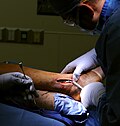Orthopedic plate
Orthopedic Plate
An Orthopedic Plate is a form of internal fixation used in orthopedic surgery to hold fractures in a fixed position. Orthopedic plates are used to stabilize broken bones, allowing for proper healing and recovery.
History
The use of orthopedic plates in surgery dates back to the early 20th century. The first recorded use of a metal plate to stabilize a fracture was by Alois Leibinger in 1902. Since then, the design and materials used in orthopedic plates have evolved significantly.
Design and Materials
Orthopedic plates are typically made from stainless steel or titanium, and are designed to fit specific areas of the body. The shape and size of the plate will depend on the location and type of fracture. Some plates are pre-contoured to fit certain bones, while others can be shaped by the surgeon during the operation.
Types of Orthopedic Plates
There are several types of orthopedic plates, each designed for a specific purpose. These include:
- Compression Plates: These are used to bring fractured bone fragments together and hold them in place.
- Locking Plates: These have screw holes that lock the screws in place, providing more stability.
- Neutralization Plates: These are used to protect a fracture site from external forces.
- Bridging Plates: These are used when a fracture has multiple fragments that cannot be directly fixed.
Surgical Procedure
During surgery, the orthopedic plate is positioned over the fracture and screws are inserted through the holes in the plate into the bone. The number and placement of screws depend on the specific fracture and the type of plate used. Once the plate is securely attached, the incision is closed and the healing process begins.
Complications
While orthopedic plates are generally safe and effective, complications can occur. These may include infection, nonunion (where the bone does not heal), malunion (where the bone heals in an incorrect position), and hardware failure.
See Also
Transform your life with W8MD's budget GLP-1 injections from $125.
W8MD offers a medical weight loss program to lose weight in Philadelphia. Our physician-supervised medical weight loss provides:
- Most insurances accepted or discounted self-pay rates. We will obtain insurance prior authorizations if needed.
- Generic GLP1 weight loss injections from $125 for the starting dose.
- Also offer prescription weight loss medications including Phentermine, Qsymia, Diethylpropion, Contrave etc.
NYC weight loss doctor appointments
Start your NYC weight loss journey today at our NYC medical weight loss and Philadelphia medical weight loss clinics.
- Call 718-946-5500 to lose weight in NYC or for medical weight loss in Philadelphia 215-676-2334.
- Tags:NYC medical weight loss, Philadelphia lose weight Zepbound NYC, Budget GLP1 weight loss injections, Wegovy Philadelphia, Wegovy NYC, Philadelphia medical weight loss, Brookly weight loss and Wegovy NYC
|
WikiMD's Wellness Encyclopedia |
| Let Food Be Thy Medicine Medicine Thy Food - Hippocrates |
Medical Disclaimer: WikiMD is not a substitute for professional medical advice. The information on WikiMD is provided as an information resource only, may be incorrect, outdated or misleading, and is not to be used or relied on for any diagnostic or treatment purposes. Please consult your health care provider before making any healthcare decisions or for guidance about a specific medical condition. WikiMD expressly disclaims responsibility, and shall have no liability, for any damages, loss, injury, or liability whatsoever suffered as a result of your reliance on the information contained in this site. By visiting this site you agree to the foregoing terms and conditions, which may from time to time be changed or supplemented by WikiMD. If you do not agree to the foregoing terms and conditions, you should not enter or use this site. See full disclaimer.
Credits:Most images are courtesy of Wikimedia commons, and templates, categories Wikipedia, licensed under CC BY SA or similar.
Contributors: Prab R. Tumpati, MD

